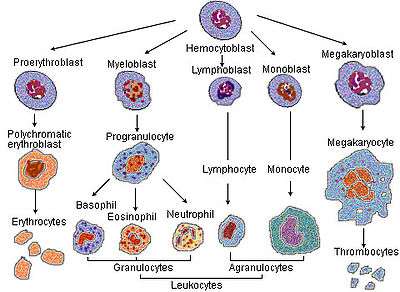Monoblast
| Monoblast | |
|---|---|
 Monoblast | |
| Identifiers | |
| Code | TH H2.00.04.3.08002 |
Monoblasts are normally found in bone marrow and do not appear in the normal peripheral blood. They mature into monocytes which, in turn, develop into macrophages.
Structure
A typical monoblast is about 12 to 20 µm in diameter, has a nuclear to cytoplasm ratio of 4:1 to 3:1, and, like most myeloid blasts, has a round to oval nucleus with fine chromatin structure. One to four nucleoli are usually visible. The nucleus can be central or eccentric and it can show evidence of indentation or folding. The cytoplasm is agranular, stains moderately to lightly basophilic, and often has an intensely stained periphery and a prominent perinuclear zone.
Maturation
The monoblast is the first stage of monocyte-macrophage maturation. The developmental stages of the monoblast are: CFU-GM (pluripotential hemopoietic stem cell or hemocytoblast) -> monoblast -> promonocyte -> monocyte-> macrophage.
Additional images
 Blood cell lineage
Blood cell lineage_diagram.png) Hematopoiesis
Hematopoiesis